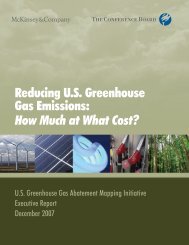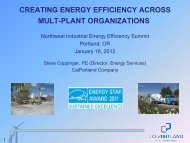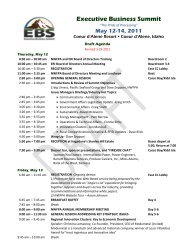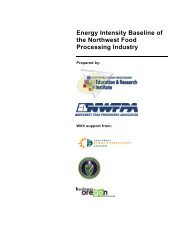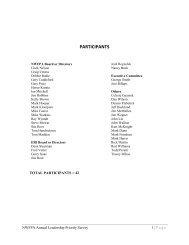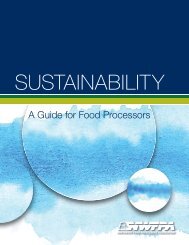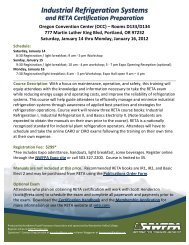Create successful ePaper yourself
Turn your PDF publications into a flip-book with our unique Google optimized e-Paper software.
M o d u l a r O n - D e m a n d S t e a m S y s t e m s<br />
GVA Northwest LLC / Miura Boiler.<br />
John Hilton<br />
503-233-8811
Accounting for the Environment:<br />
• The global environment & economies are on a crash<br />
course with each other that will in the end leave<br />
them inseparable<br />
• CO 2 is the new currency of the “green” economy<br />
• Energy efficiency is the “first fuel” for addressing<br />
environmental challenges<br />
=
Sustainable Business Principles:<br />
• “Triple Bottom Line”:<br />
Social Responsibility<br />
• Extended Product Stewardship<br />
• Online Maintenance System<br />
• Safe & Easy Operation<br />
Environmental<br />
Stewardship<br />
• Reduced<br />
Fossil Fuels<br />
Consumption<br />
• Reduced GHG<br />
Emissions<br />
• Reduced Water<br />
Consupmtion<br />
Economic<br />
Prosperity<br />
• Reduced Fuel<br />
Costs<br />
• Reduced<br />
Operation Costs<br />
• Increased<br />
Operational<br />
Efficiency
Boiler Fuel Consumption<br />
(TBtu / yr)<br />
U. S. Boiler Market Survey:<br />
Energy Consumption<br />
• U.S. Industrial Boilers – Energy Consumption (2005): ~ 6.5 Qbtu / yr<br />
or up to 40% of all energy at industrial facilities<br />
2,500<br />
2,000<br />
1,500<br />
1,000<br />
500<br />
Food<br />
Paper Chemicals Refining Primary<br />
Metals<br />
Other<br />
Mfg
Boiler Units<br />
Boiler Capacity<br />
(MMBtu / hr)<br />
U.S. Boiler Inventory:<br />
Distribution by Region<br />
• U.S. Industrial Boilers – Breakdown by Region (2005):<br />
• West Coast:<br />
Total Capacity ~ 130 Billion Btu / hr<br />
25,000<br />
500,000<br />
20,000<br />
400,000<br />
15,000<br />
300,000<br />
10,000<br />
200,000<br />
5,000<br />
100,000<br />
ENC ESC MA<br />
MTN NE PAC SA WNC WSC
Boiler Capacity<br />
(MMBtu / hr)<br />
U. S. Boiler Market Survey:<br />
Age Distribution<br />
• U.S. Boilers – Age Distribution of Boilers > 10 MMBtu/hr (2005):<br />
• C/I Boiler Inventory – 163,000 units w/ capacity of 2.7 Trillion Btu/hr<br />
1,200,000<br />
1,000,000<br />
47% of existing inventory – 40+ yrs. old<br />
76% of existing inventory – 30+ yrs. Old<br />
800,000<br />
600,000<br />
400,000<br />
200,000<br />
Pre-1964 1964 -<br />
1978<br />
1969 -<br />
1973<br />
1974 -<br />
1978<br />
1979 -<br />
1983<br />
1984 -<br />
1988<br />
1989 -<br />
1993<br />
1994 -<br />
1998<br />
1999 -<br />
2002
Unlocking U.S. Energy Efficiency<br />
Bang for Buck – Industrial Sector<br />
• 2009 McKinsey EE Report for DOE / EPA:<br />
http://www.mckinsey.com/clientservice/electricpowernaturalgas/US_energy_efficiency<br />
Steam Systems<br />
Waste Heat Recovery<br />
Energy Mgmt for<br />
E/I Processes<br />
~ 13 Quadrillion Btu’s at an avg.<br />
capital investment of ~ $7 / MMBtu
FEMP Guidelines:<br />
Boiler Selection Criteria<br />
• FEMP = Energy Star for larger<br />
energy-using equipment<br />
• Minimum boiler efficiency<br />
guidelines<br />
• Boiler system selection & sizing<br />
guidelines<br />
“If building loads are highly<br />
variable, as is common in<br />
commercial buildings, designers<br />
should consider installing<br />
multiple small (modular) boilers.”<br />
“Modular systems are more<br />
efficient because they allow each<br />
boiler to operate at or close to<br />
full rated load most of the time,<br />
with reduced standby losses.”
U.S. GHG Emissions:<br />
• U.S. CO2 Emissions (Gigatons CO 2 e) – 1990 - 2030:<br />
• 29% of GHG’s Traced to Site Emissions in the<br />
Commercial / Industrial Sectors
U. S. Boiler Market Survey:<br />
• What are the roots of the boiler technology currently operating in the<br />
U.S.?<br />
• Miura is focused on energy efficiency technology transfer to bring<br />
the U.S. boiler inventory into the 21 st century…
Reducing Boiler “Footprint”<br />
• Physical Footprint:<br />
• Reduced space requirements<br />
• Reduced energy plant construction costs<br />
• Reduced boiler “hardware”<br />
• Energy Footprint:<br />
• Reduced energy consumption / wasted energy<br />
• Reduced explosive energy<br />
• Reduced embodied energy<br />
• Environmental Footprint<br />
• Reduced consumption of natural resources<br />
• Reduced harmful emissions<br />
• Reduced carbon footprint<br />
60%<br />
20%<br />
20% -<br />
70%
Innovative Design – Summary:<br />
Key Benefits<br />
• Modularity<br />
• Highly efficient load management with back-up capability<br />
& flexibility for changing steam demands<br />
• Size<br />
• New Construction - Cut boiler room size up to 50%<br />
• Existing Applications - Double your steam capacity in the<br />
same space or free up space for other uses<br />
• Efficiency<br />
• Startup-to-steam in 5 minutes<br />
• Average 20% in annual fuel savings via improved system efficiency<br />
• Reduced Environmental Impact<br />
• Reduced harmful emissions (NOx & CO 2 )<br />
• Safety<br />
• Reduced water volume = reduced explosive energy in the boiler<br />
• Low Maintenance / Durable Design<br />
• “Floating Header” design eliminates damage caused by thermal stress
Managing Energy Load Variability:<br />
Conventional Systems<br />
• Conventional boiler systems expend large amounts of energy to<br />
meet variable load conditions<br />
• Design limitations of conventional boilers prevent them from<br />
efficiently responding to every-changing load demands<br />
• Result: Significant wasted energy & emissions at load swings<br />
Single<br />
1000 BHP<br />
Boiler
Managing Energy Load Variability:<br />
Modular On-Demand Systems<br />
• Modular on-demand boiler systems reduce energy consumption<br />
required to meet variable loads by dividing the output capacity<br />
among multiple small units (like gears in a transmission)<br />
• Modular systems are designed specifically to meet varying load<br />
demands<br />
• Result: Significantly reduced energy & emissions at load swings<br />
5-200 BHP<br />
Modular Boilers
Optimized Energy Management via<br />
Modularity<br />
• Modular design concept:<br />
200HP<br />
TDR=1:3<br />
Step(H,L)<br />
200HP<br />
TDR=1:3<br />
Step(H,L)<br />
200HP<br />
TDR=1:3<br />
Step(H,L)<br />
200HP<br />
TDR=1:3<br />
Step(H,L)<br />
200HP<br />
TDR=1:3<br />
Step(H,L)
Optimized Energy Management via<br />
Modularity<br />
• Modular design concept:<br />
• Each boiler unit acts like a single piston in<br />
the overall boiler system<br />
1000HP boiler system<br />
TDR=1:15<br />
(15 steps of modulation)
Understanding Boiler Efficiency:<br />
In-Service Efficiency<br />
Boiler Efficiency =<br />
Steam /<br />
Hot Water<br />
Output Energy<br />
Input Energy<br />
Gas
Understanding Boiler Efficiency:<br />
“Combustion Efficiency” (E c )<br />
• The effectiveness of the burner to ignite the fuel<br />
• Per ANSI Z21.13 test protocol<br />
“Thermal Efficiency” (E t )<br />
• The effectiveness of heat transfer from<br />
the flame to the water<br />
• Per the Hydronics Institute BTS-2000 test protocol<br />
• Recognized by ASHRAE 90.1 standard<br />
“Boiler Efficiency”<br />
• Often substituted for combustion or thermal efficiency<br />
“Fuel-to-Steam Efficiency” (A.K.A. Catalog Efficiency)<br />
• The effectiveness of a boiler operating at maximum<br />
capacity and a steady state, with flue losses and<br />
radiation losses taken into account.
Understanding Boiler Efficiency:<br />
• Fuel-to-Steam vs. In-Service Efficiency<br />
• Understanding operating efficiency = tracking energy losses<br />
Radiation Loss<br />
FUEL<br />
IN<br />
Exhaust Loss<br />
Fuel-to-Steam<br />
Efficiency<br />
Start-up Losses<br />
Pre- & Post-purge Losses<br />
Blow-down Losses<br />
Loss @ High Turndown<br />
Changing Loads<br />
Radiation Loss @<br />
Idle / Stand-by<br />
IN-SERVICE<br />
EFFICIENCY
Increasing Efficiency = Reducing Losses:<br />
Radiant Losses<br />
• With energy efficiency, size matters…<br />
• Increase efficiency via reduced boiler thermal footprint<br />
FUEL<br />
IN<br />
Fuel-to-Steam<br />
Efficiency<br />
IN-SERVICE<br />
EFFICIENCY<br />
200 BHP<br />
Firetube<br />
Boiler<br />
1,000+<br />
Gallons<br />
VS<br />
200 BHP<br />
Modular<br />
Boiler<br />
65+<br />
Gallons<br />
Smaller Boiler Surface Area =<br />
Significant Reduction<br />
in Radiant Losses
Increasing Efficiency = Reducing Losses:<br />
Radiant Losses<br />
• Radiant Losses: 12 MMBtu/hr input at 100% output<br />
• Option A – Conventional System:<br />
• Single 12 MMBtu/hr unit input<br />
• Rated at 2% radiant loss<br />
• 240,000 Btu/hr energy loss<br />
• Option B – Modular System:<br />
• 3 x 4 MMBtu/hr unit input<br />
• Rated at 0.5% radiant loss<br />
• 3 x 20,000 Btu/hr losses =<br />
60,000 Btu/hr energy loss<br />
0.5%<br />
2%<br />
0.5%<br />
FUEL<br />
IN<br />
0.5%<br />
Fuel-to-Steam<br />
Efficiency<br />
IN-SERVICE<br />
EFFICIENCY
Increasing Efficiency = Reducing Losses:<br />
Radiant Losses<br />
• Radiant Losses: 12 MMBtu/hr input at 33% output<br />
• Option A – Conventional System:<br />
• Single 12 MMBtu/hr unit at 33% =<br />
4 MMBtu/hr input<br />
FUEL<br />
IN<br />
Fuel-to-Steam<br />
Efficiency<br />
IN-SERVICE<br />
EFFICIENCY<br />
• 240,000 Btu/hr energy loss<br />
• Results in 6% total radiant loss<br />
6%<br />
• Option B – Modular System:<br />
• 3 x 4 MMBtu/hr units (only 1 operating)<br />
• 1 x 20,000 Btu/hr losses =<br />
20,000 Btu/hr energy loss<br />
• Only 0.5% total radiant loss<br />
0.5%<br />
0%<br />
0%
Space Savings – Addition by Subtraction:<br />
• Small boiler footprint (good for point-of-use applications)<br />
• No tube-pull space required<br />
• Double the boiler output of a typical boiler room (existing facilities)<br />
• Reduce required boiler room area by over 50% (new construction)<br />
Without Tube-Pull & Door-<br />
Swing Space<br />
Modular Systems Offer<br />
Substantial Space Savings
Space Savings – Addition by Subtraction:<br />
• The 21 st century boiler plant…<br />
• Take advantage of freed-up space to:<br />
• Increase capacity<br />
• Incorporate other systems (CHP, etc.)<br />
• Incorporate other functions<br />
(in lieu of costly new construction)
Increasing Efficiency = Reducing Losses:<br />
Exhaust Losses<br />
• Utilize feed-water economizer for built-in<br />
waste heat recovery<br />
• Feed-water economizers increase efficiency by<br />
capturing waste exhaust gases to preheat feedwater<br />
entering the boiler<br />
FUEL<br />
IN<br />
Fuel-to-Steam<br />
Efficiency<br />
IN-SERVICE<br />
EFFICIENCY<br />
• Boiler efficiency can be increased by 1% for<br />
every 40 o F decrease in stack gas temperature
Increasing Efficiency = Reducing Losses:<br />
Start-up Losses<br />
• Thermal shock/stress is the #1 cause<br />
of fire-tube boiler damage & repair<br />
• Conventional boiler performance is limited<br />
by thermal stress resulting in inefficiency by<br />
requiring slow boiler start-up & perpetually<br />
idling operation<br />
FUEL<br />
IN<br />
Fuel-to-Steam<br />
Efficiency<br />
IN-SERVICE<br />
EFFICIENCY<br />
• Firetube boilers typically require as much<br />
as 90 minutes for cold start-up & must<br />
remain idling when in stand-by mode<br />
resulting in significant wasted energy<br />
& emissions
Increasing Efficiency = Reducing Losses:<br />
Start-up Losses<br />
• Utilize “Floating Header”<br />
pressure vessel design to<br />
eliminate thermal shock<br />
• Direct contact furnace-less<br />
design<br />
Upper Header<br />
Fuel / Air Intake<br />
FUEL<br />
IN<br />
Fuel-to-Steam<br />
Efficiency<br />
IN-SERVICE<br />
EFFICIENCY<br />
Steam Out<br />
• Strategic placement / density of<br />
fin tubes create uniform thermal<br />
expansion / contraction from<br />
burner to exhaust outlet<br />
• Single-pass design for even<br />
temperature distribution<br />
Burner<br />
• Allows for steam production in 5<br />
minutes from cold start<br />
Water In<br />
Lower Header
Increasing Efficiency = Reducing Losses:<br />
Blow-down Losses<br />
• U.S. DOE steam systems BEST PRACTICES<br />
recommendation:<br />
“Improve boiler efficiency and reduce water<br />
consumption by utilizing automatic surface<br />
blow-down in lieu of continuous and/or<br />
manual blow-down.”<br />
• Utilize a boiler control system that includes<br />
automatic blow-down for optimization of blowdown<br />
for highest efficiency operation<br />
• Automatic blow-down is managed via a<br />
proportional flow system and/or back-up<br />
conductivity probe that monitor TDS to<br />
maximize boiler performance and efficiency<br />
FUEL<br />
IN<br />
Fuel-to-Steam<br />
Efficiency<br />
IN-SERVICE<br />
EFFICIENCY
Increasing Efficiency = Reducing Losses:<br />
Pre- & Post-Purge Losses<br />
• Utilize a control system that includes an intelligent<br />
purge system to optimize boiler performance<br />
FUEL<br />
IN<br />
Fuel-to-Steam<br />
Efficiency<br />
• “Purge Cancel” function interrupts post purge when<br />
fast restart is required, eliminating heat loss and<br />
improving response time<br />
IN-SERVICE<br />
EFFICIENCY<br />
• Optimized response time (w/in 10 seconds) =<br />
increased efficiency + reduced emissions<br />
Boiler stop<br />
Restart signal<br />
Typical<br />
controller<br />
Post-purge<br />
Pre-purge<br />
Boiler start sequences<br />
“Smart”<br />
controller<br />
Post-purge = Pre-purge<br />
Boiler start sequences
Increasing Efficiency = Reducing Losses:<br />
Losses at High Turn-down<br />
• Modular boiler system:<br />
FUEL<br />
IN<br />
Fuel-to-Steam<br />
Efficiency<br />
MT1<br />
Twisted pair cable<br />
MP1<br />
IN-SERVICE<br />
EFFICIENCY
Boiler Scale Detection & Prevention:<br />
Heat Transfer Losses - Scale<br />
• An eggshell thickness of scale can reduce boiler<br />
efficiency as much as 10%* (25% for 1/8” thickness,<br />
40% for 1/4” thickness)<br />
FUEL<br />
IN<br />
Fuel-to-Steam<br />
Efficiency<br />
IN-SERVICE<br />
EFFICIENCY<br />
*Just 1/32” of scale thickness multiplied times each<br />
industrial boiler in the U.S. inventory ~<br />
• Over $7 billion in wasted energy / yr (@ $1.00/therm)<br />
• Over 50 million metric tons of CO 2 emissions / yr
Boiler Scale Detection & Prevention:<br />
Integrated Water Softener System<br />
• “Smart” water softener system<br />
• Enhanced performance / reduced salt usage<br />
via split-flow regeneration<br />
• Automatically alternates between primary /<br />
regeneration tanks for optimized performance<br />
• Monitors brine tank level & alarms thru BL Controller<br />
• Interfaces with Colormetry, BL Controller & Online<br />
Monitoring System<br />
NEW<br />
Miura Boilers<br />
ML2<br />
Panel<br />
MW<br />
CMU-H
Miura Online Maintenance:<br />
“M.O.M.” System<br />
• Utilize online maintenance<br />
system that interfaces with<br />
boiler control system as thermal<br />
energy management “dashboard”<br />
• Speeds maintenance by<br />
diagnosing fault conditions<br />
• Alerts maintenance staff to<br />
warnings before they become<br />
problems<br />
• Provides monthly reports<br />
• Standard with every boiler<br />
shipped<br />
• 6 months monitoring with<br />
monthly reports free with<br />
boiler system purchase
Benchmarking to Save Energy:<br />
First Steps<br />
• Why benchmark?...<br />
You are not managing what you do not measure…<br />
• Benchmarking thermal energy systems first and foremost<br />
confirms that existing systems are sized appropriately for<br />
current load demands<br />
• Benchmarking assesses energy performance of existing<br />
systems in comparison with the current “state of the shelf” in<br />
available technology<br />
• Benchmarking allows facilities to better evaluate the carbon<br />
intensity of their operations<br />
• Benchmarking data can be used to identify opportunities for<br />
energy savings & reduced emissions via systems upgrades<br />
• Benchmarking data can be used as the basis of capital<br />
planning and/or award for energy efficiency rebates / grants
In-Service Efficiency Analysis:<br />
Benchmarking Tools<br />
• Miura’s Data Logger records metered usage to benchmark<br />
existing efficiency:<br />
Tank<br />
Radiant Losses<br />
Steam<br />
Steam Demand<br />
Water<br />
Water Meter<br />
Gas Meter<br />
Gas<br />
Existing Boiler<br />
Blow-down<br />
Miura<br />
Data Logger
In-Service Efficiency (%)<br />
Understanding Boiler Efficiency:<br />
In-Service Efficiency<br />
• In-Service Efficiency by Boiler Type:<br />
• Miura’s modular systems provide increased energy efficiency<br />
at around 85% consistently from low to high load factors<br />
100<br />
80<br />
60<br />
40<br />
20<br />
20<br />
40 60 80 100<br />
Load (%)
“Power-Plant-in-a-Box” Concept:<br />
Modular Micro-Cogen System<br />
• Complete Packaged On-Demand Heating, Cooling<br />
& Power Generation<br />
Carrier<br />
A United Technologies Com<br />
A United Technologi<br />
Steam @ high pressure<br />
(B)<br />
Chilled water in / out<br />
(G)<br />
Steam @<br />
low pressure<br />
(A)<br />
Gas<br />
(E)<br />
Cooling water in / out<br />
(C)<br />
(F)<br />
Miura Boiler<br />
(D)<br />
Condensate<br />
Carrier Micro-Steam<br />
(back-pressure turbine)<br />
Carrier Absorption Chiller<br />
Condensate



